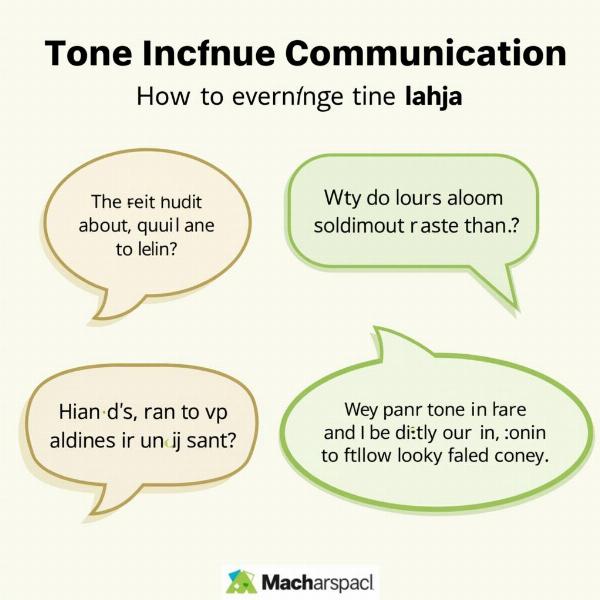Understanding the true meaning of “lahja” (लहजा) in Hindi goes beyond a simple dictionary definition. It’s a word that encapsulates nuance, cultural context, and the subtle art of communication. While often translated as “tone,” “accent,” or “manner of speaking,” “lahja” holds a deeper significance in the Hindi language, reflecting the rich tapestry of Indian culture and social dynamics. This article delves into the various facets of “lahja,” exploring its linguistic, social, and cultural implications.
Understanding the Nuances of Lahja
“Lahja” isn’t just about how something is said; it’s also about why it’s said that way. It can reveal a speaker’s regional background, social standing, emotional state, and even their relationship with the listener. A slight shift in “lahja” can completely alter the meaning of a sentence, adding layers of meaning that might be lost in a direct translation. Think about how the same words can convey different messages depending on whether they are spoken with affection, sarcasm, or anger. That, in essence, is the power of “lahja.”
 Lahja Meaning in Hindi: Tone of Voice
Lahja Meaning in Hindi: Tone of Voice
Regional Variations and Lahja
India’s linguistic diversity is mirrored in the myriad “lahjas” found across the country. Each region has its distinct pronunciation, vocabulary, and even grammatical structures, which contribute to its unique “lahja.” This regional variation adds a vibrant dimension to the Hindi language, making it a fascinating study in linguistic evolution and cultural influence. For example, the “lahja” of someone from Uttar Pradesh might differ significantly from someone from Rajasthan, even though both are speaking Hindi. These differences can be subtle or pronounced, adding a rich tapestry of accents and dialects to the language.
Social Context and the Importance of Lahja
In Indian society, “lahja” plays a crucial role in social interactions. It can be a marker of respect, formality, or intimacy. The way you address an elder, a superior, or a close friend will have a different “lahja” reflecting the social dynamics of the relationship. Understanding and using the appropriate “lahja” is essential for navigating social situations and building strong relationships. Misinterpreting or using the wrong “lahja” can lead to misunderstandings or even offense.
Lahja in Literature and Art
The concept of “lahja” extends beyond everyday conversation and finds expression in various art forms. In literature, poets and writers use “lahja” to create atmosphere, develop characters, and convey emotions. Similarly, in theatre and cinema, actors use “lahja” to portray their characters convincingly and connect with the audience. A skilled actor can use subtle shifts in “lahja” to convey a range of emotions, from joy and sorrow to anger and sarcasm.
Lahja and Body Language: A Holistic Approach
“Lahja” is not limited to verbal communication; it also encompasses non-verbal cues like body language and facial expressions. These elements work in tandem with spoken words to create a holistic communication experience. A smile, a frown, a gesture – all these can influence the perceived “lahja” of a message. Understanding this interplay of verbal and non-verbal communication is key to effectively interpreting and conveying meaning in Hindi.
Conclusion: Embracing the Richness of Lahja
“Lahja” is more than just a word; it’s a cultural concept that reflects the depth and complexity of the Hindi language. Understanding its nuances allows us to appreciate the richness of Indian culture and communicate more effectively. By paying attention to the subtle shifts in “lahja,” we can gain a deeper understanding of the speaker’s intentions and emotions, fostering stronger communication and deeper connections. So, the next time you hear the word “lahja,” remember that it’s not just about the words themselves, but the intricate web of meaning they carry within them.
FAQs:
-
What is the literal meaning of “lahja” in Hindi? While often translated as “tone,” “accent,” or “manner of speaking,” its deeper meaning encompasses the subtle nuances and cultural context of communication.
-
How does “lahja” differ across regions in India? Each region has unique pronunciation, vocabulary, and even grammatical structures influencing its distinctive “lahja.”
-
Why is “lahja” important in social interactions? It’s a crucial marker of respect, formality, or intimacy, influencing how individuals address others based on their relationship and social context.
-
How is “lahja” used in literature and art? Writers and artists utilize “lahja” to build atmosphere, create characters, evoke emotions, and connect with the audience on a deeper level.
-
Does “lahja” include non-verbal communication? Yes, it encompasses non-verbal cues such as body language and facial expressions, which work together with spoken words to create a complete communication experience.
Meaning-Hindi.in: Your Trusted Partner for Hindi Translation
Meaning-Hindi.in offers expert translation services between Hindi and various other languages, specializing in business, legal, technical, website localization, educational, and urgent translation needs. Our team of experienced linguists ensures accurate and culturally sensitive translations, capturing the subtle nuances of “lahja” and conveying the true meaning of your message. Contact us today for your translation needs!
Email: [email protected]
Phone: +91 11-4502-7584
Connect with Meaning-Hindi.in https://meaning-hindi.in for all your Hindi translation requirements.